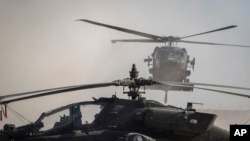U.S. helicopters swooped into the northwestern Syrian countryside near the city of Jarablus under cover of darkness and, despite reports of heavy gunfire, took off again with a rising Islamic State leader in custody, striking the latest blow against the terror organization.
U.S. military and counterterrorism officials have been hesitant to share many details of the early Thursday morning raid that resulted in the capture of Hani Ahmed al-Kurdi, described as one of the group’s more senior leaders and crucial to its recent exploits in Syria.
“The mission to capture al-Kurdi was meticulously planned to minimize the risk of civilian harm or collateral damage,” the U.S.-led coalition to defeat IS said in a statement.
“The successful mission avoided any harm to civilians or civilian infrastructure and resulted in no damage to coalition aircraft or assets,” the statement added.
Separately, a U.S. official speaking to VOA on the condition of anonymity in order to discuss intelligence confirmed that none of the U.S. forces involved in the raid were hurt.
As for al-Kurdi, the official described the former bombmaker as an “operational facilitator” who had risen through the ranks to become a key planner behind the terror group’s Syrian operations.
A coalition statement further described al-Kurdi as a being “responsible for coordinating terrorist activities across the region … and facilitating attacks on U.S. and partner forces.”
While al-Kurdi is perhaps not as well-known as other IS officials and ideologues, his name is familiar to analysts who study IS, some of whom told VOA his capture will deal a blow to IS’s plans for Syria, and perhaps even its future.
“To fully dismantle an organization like ISIS, it is crucial to identify and arrest individuals like al-Kurdi, given his expertise as a bombmaker,” said Colin Clarke, director of research at the global intelligence firm The Soufan Group, using a different acronym for the terror group.
“Someone with these types of skills participates in tacit knowledge transfer, passing down these skills to others within the organization,” Clarke said. “In practical terms, this is a really big deal to take someone like this off the battlefield.”
In the immediate aftermath of the U.S. raid, the IS social media account sought to downplay the significance.
Chatter tracked by JihadoScope, a company that monitors online activity by Islamist extremists, found IS-linked accounts immediately describing the raid as a failed operation, arguing a U.S. helicopter was damaged.
U.S. officials have rejected such assertions, but war monitors on the ground in Syria suggest IS may have escaped an even bigger blow.
The British-based Syrian Observatory for Human Rights said Thursday that the area U.S. forces targeted was home to multiple, high-ranking IS officials and fighters but that many were able to escape and hide after getting word of an approaching U.S. aircraft.
The observatory also said that in addition to al-Kurdi, U.S. forces captured two of his IS escorts — a claim U.S. officials haven't confirmed.
Thursday’s raid near Jarablus is the latest in a series of counter-IS operations to focus on northwestern Syria.
In February U.S. special forces descended on Atmeh, a town in Syria’s northwestern, Idlib province, as part of an operation that led to the death of then-leader Abu Ibrahim al-Hashimi al-Qurashi.
IS’s first leader, Abu Bakr al-Baghdadi, died following a U.S. raid in northwestern Syria in October 2019, and intelligence from multiple countries, including the U.S., has suggested remnants of IS have long seen the region as a relatively safe base of operations, due in part to the presence of several other terror organizations.
But there are indications that IS operatives and fighters in northwestern Syria are coming under increasing pressure, including from other terror groups in the region.
On Tuesday, Hayat Tahrir al-Sham (HTS), a terror group that evolved out of the former al-Qaida affiliate Jabhat al-Nusra, announced it had launched an operation against IS in the Idlib area.
"Among those arrested are officials and leaders … [who] hold sensitive positions in the province, the most important being the securing of roads and supplies," HTS said in a statement translated by the SITE Intelligence Group.
Other IS cells across Syria and Iraq also appear to be feeling squeezed.
Both the U.S.-backed Syrian Democratic Forces and Iraqi counterterrorism forces have claimed a series of major successes in operations targeting regional IS leaders and cells.
“It’s one thing to take out the top guys. It’s another to start chipping away at those working on issues closer to the ground level and tactical actions,” said Aaron Zelin, a fellow at the Washington Institute for Near East Policy who specializes in jihadism.
“It could portend to more operations that further dismantle second-tier leadership depending on what type of intel is gleaned,” he told VOA.
Turkey also may have struck a major blow against IS late last month, claiming an operation in Istanbul had resulted in the capture of the new IS leader, known as Abu al-Hassan al-Hashimi al-Qurashi.
U.S. and other Western counterterrorism officials so far have declined to confirm the identity of the IS official in Turkish custody. Sources with knowledge of the arrest, speaking on the condition of anonymity because of the sensitivity of the matter, have told VOA the person in custody is likely a key IS official.










